Increasing your SMS response rates can significantly impact your business's communication effectiveness. By making your messages concise, conversational, and personalized, you can enhance engagement and drive better results.
Here are 11 practical tips to help you improve your SMS response rates and connect more effectively with your audience.
11 ways to improve your SMS response rates
Follow these 11 tips and best practices to increase the chances of your leads, prospects, and customers responding to your text campaigns—and to reduce opt-outs.
1. Keep messages short
The recommended length for texting is 160 characters. Some messages will need to be longer due to required compliance verbiage. At max, longer texts should not exceed 320 characters.
There are several reasons that short messaging increases response rates:
- Long messages may get broken up into multiple messages and arrive out of order.
- Long messages are easily mistaken by carriers—and customers—for spam (Source).
- Consumers prefer text because of its brevity, and are therefore more likely to respond to quick and digestible messages (Source).
- Messages perceived as overly complex or lengthy can be mistaken for scams by consumers (Source).

2. Stay conversational
If you want your SMS recipients to respond, then treat it like you’re talking to them on the phone. A long soliloquy about your business isn’t going to invite a response, even if you include CTA at the end. Personalize the message, get to the point (just ONE point) quickly, and ask a question. You’re not trying to convince them to buy your product or service here. You’re just trying to engage them.
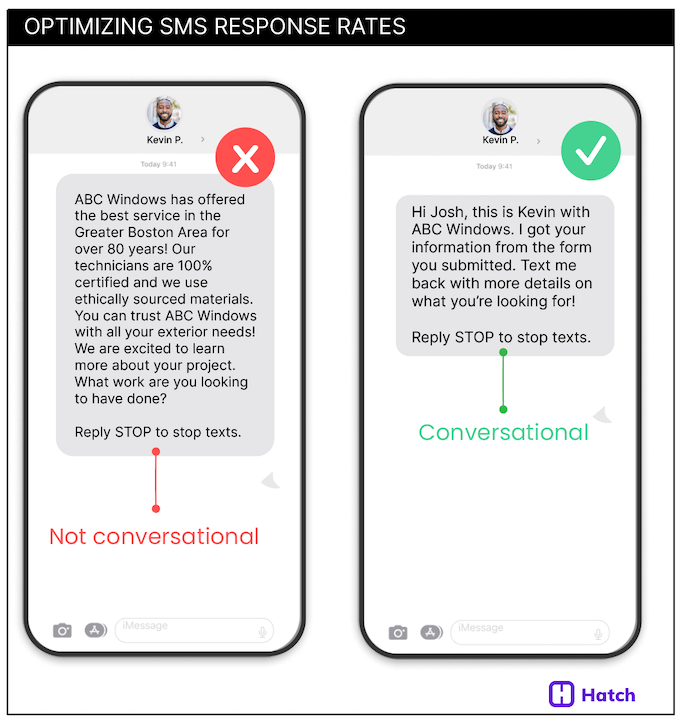
3. Make it informal
While it’s important to remain professional and earn trust, overly formal messages can sometimes be less engaging or come off as too stiff. Don’t use industry jargon, fancy vocabulary, and when introducing yourself, use your first name only. People want to feel like people are texting them, not businesses.
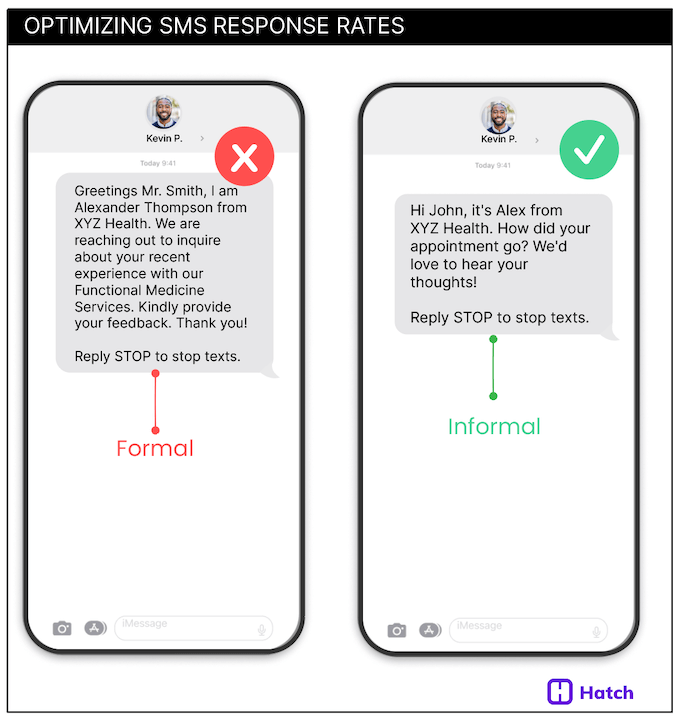
4. Avoid spam trigger words
Spam trigger words can cause a consumer to mistake your message as spam and ignore it (aka not respond), or a carrier to flag or filter out your message entirely. A customer can’t respond to a message they never received!
- “Financial gain” spam words:
- Save up to
- Save big money
- Billions
- Money back
- $$$
- “Freebie” spam words:
- Free $$$
- Free preview
- Free access
- Free trial
- Free money
- “Exaggerated claim” spam words:
- Risk-free
- 100% satisfied/free/more
- guarantee
- “FOMO” spam words:
- This won’t last
- You have been selected
- Take action
- Limited time
- Don’t delete
- General-use SMS spam words:
- Important information regarding
- Information you requested
- Requires initial investment
- Social security number
- Check or money order
5. Avoid other spammy elements
It’s not just the words you use in your SMS campaigns that can trigger spidey spam senses. You need to make sure the overall message is:
- Is personalized
- Uses natural language
- Adds value
- Isn’t “loud” (think all caps, lots of exclamations)
- Looks clean (words with Inconsistent capitalization Can Often appear phishy).
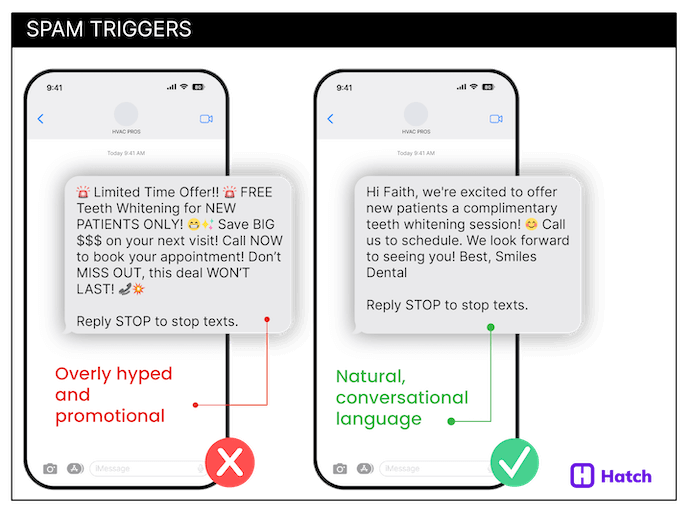
6. Segment your campaigns for tailored messaging
Mass text blasts to your entire audience are not going to get you high response rates. Instead, create segments out of your database so you can create messages tailored to their needs, their particular stage in the customer journey, and their prior history with your business
Here are some audience segment examples:
- New leads from X lead source
- Aged leads who haven’t booked an appointment
- Leads who booked an appointment but canceled
- Recently quoted prospects
- Prospects who were quoted a month ago
- Closed lost prospects due to timing
- Customers who have signed but whose project has yet to start
- Customers with recently completed projects
- Customers who have given you a 5 star review
- Customers who have given you a 1 star review
- Membership customers with upcoming recurring services
With segments like this, you can create specific offers and messages that resonate and earn responses. This is why you should look for audience targeting capabilities when considering communication platforms.
Hatch, for example, integrates with your lead sources and CRM so you can create granular audiences based on specific behaviors and properties.
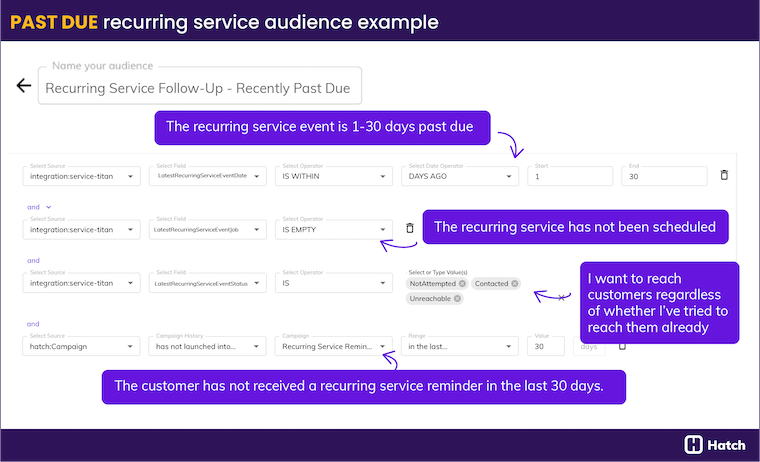
7. End with a clear ask
We always tell our customers, “Go for the ask, not the sell.” The goal when reaching out, especially over text, is not to convince them of everything about your business and credibility and to land the sale. it’s to get them to respond so you can get the conversation started. This is why short messages with clear CTAs lead to higher conversion rates.
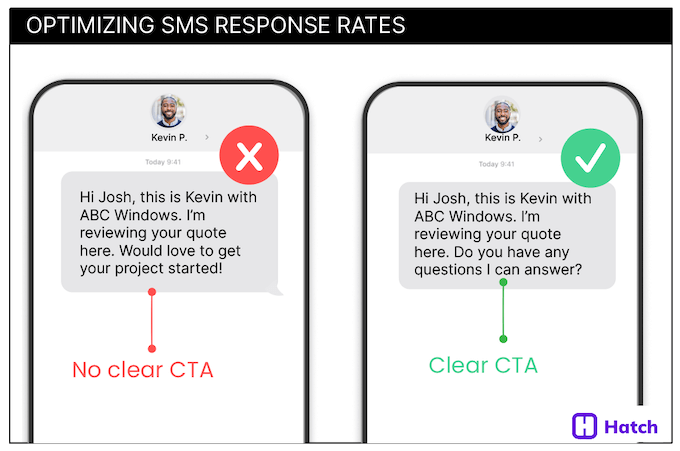
8. Reach out early
One of the best ways to get customers to respond has nothing to do with what your SMS message says, but when it gets sent. In a world of instant gratification and endless distractions, speed is essential.
Here are some outreach speeds to strive for to optimize chances of response:
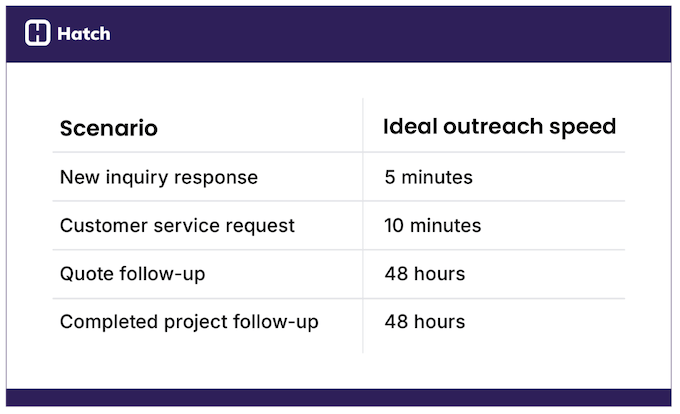
9. Reach out often
Consumers today are more distracted than ever. The good news about this is that a lack of response does not mean lack of interest. It takes an average of eight touches to get a new lead to respond, and anywhere from 5-12 follow-ups to close a deal.
So whether you are texting your contacts to respond to inquiries, follow up on quotes, or engage current customers, you need to be reaching out multiple times if you want a response.
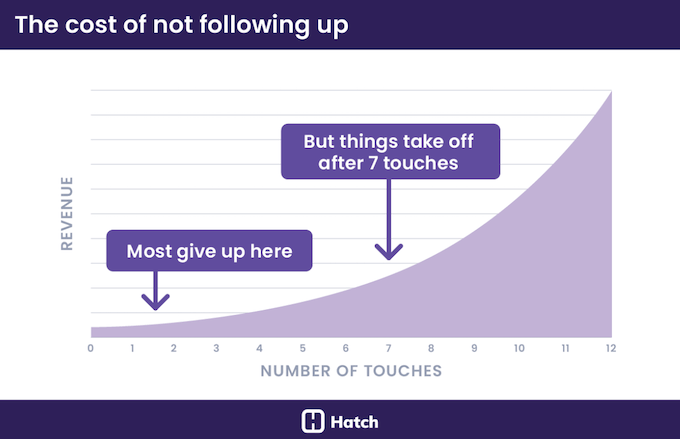
10. But pace it out
Now this does not mean reaching out 12 times in one day. It means staggering it out over several days, and saying something different each time you reach out.
Hatch’s automation, for example, is built for these multi-channel, multi-touch sequences, as opposed to one-off sends. Below is an example of an 11-day, 10-touch sequence, with intermittent pauses:
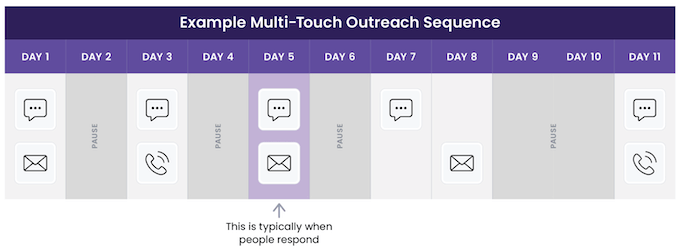
11. Use other channels
While SMS has the highest response rates, it’s best to combine your text outreach with email and voice. After all, 89% of consumers expect brands to allow them to interact through multiple channels, and companies that use three or more channels see 250% higher engagement rates than companies that only use one channel
Response rates for any one channel are higher when employed with other channels than when employed in isolation.
Use these tips to increase your SMS response rates
Implementing these 11 strategies can transform your SMS marketing efforts, leading to higher response rates and better customer interactions. Remember to keep your messages short, conversational, and tailored to your audience’s needs. By doing so, you'll create a more engaging and effective SMS campaign.
To summarize, here's how to keep your response rates high:
- Keep messages short
- Stay conversational
- Make it informal
- Avoid spam trigger words
- Avoid other spammy elements
- Segment your campaigns for tailored messaging
- End with a clear ask
- Reach out early
- Reach out often
- Pace it out
- Use other channels